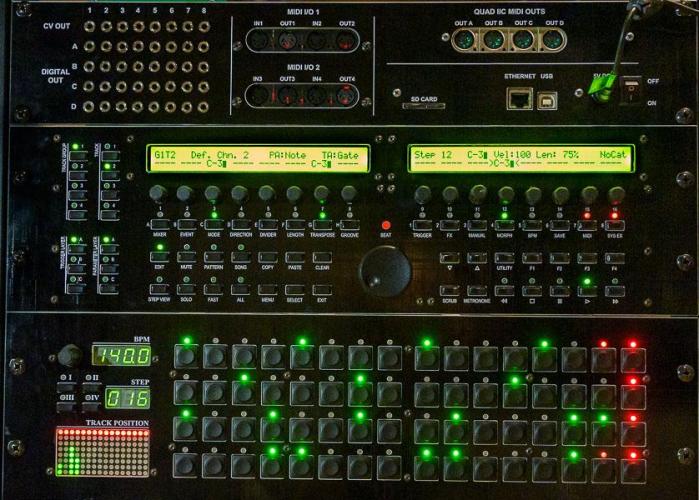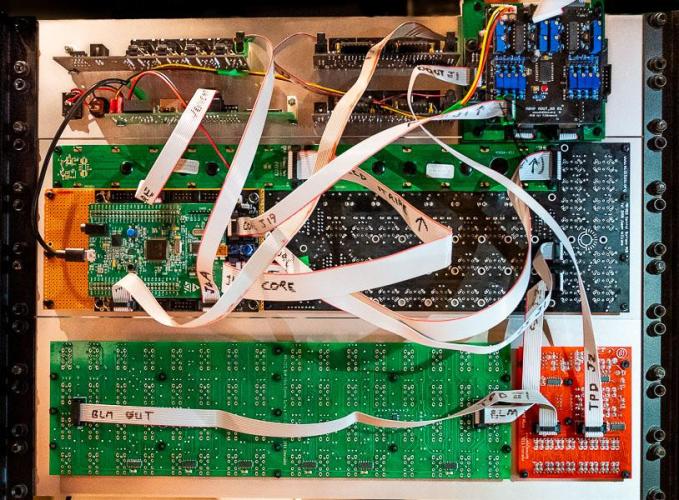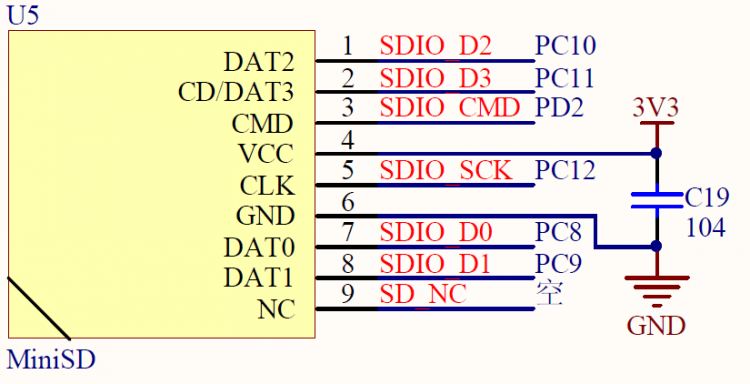Search the Community
Showing results for 'STM32F4'.
-
I have an STM32F4 that refuses to work with both SD & ENC28J60 ethernet modules using MIDIbox NG & CV V2. Working: Ethernet and no SD When I boot it without an SD inserted, the ethernet works fine: Ethernet cable connected: yes Ethernet MAC address: 00:39:36:30:39:31 Ethernet services running: yes DHCP: enabled IP address: 192.168.0.100 Netmask: 255.255.255.0 Default Router (Gateway): 192.168.0.1 Not Working: SD and ethernet together (ethernet gets disabled) However, the moment I insert an SD card, I get various errors and the ethernet disconnects: [MIOS32_ENC28J60_PackageReceive] glitch detected - Ptr: ff09, Status: 7fb8 (max: 05ee) cd7f or [MIOS32_ENC28J60_PackageReceive] glitch detected - Ptr: ffff, Status: ffff (max: 05ee) ffff Working: SD and no ethernet If I boot with the SD card inserted, the MAC address is recognized but the plugged-in ethernet cable isn't detected (which could be due to another error): Ethernet cable connected: no Ethernet MAC address: 00:39:36:30:39:31 Ethernet services running: no DHCP: enabled IP address: not available yet Netmask: not available yet Default Router (Gateway): not available yet When this happens, my router actually recognizes the ENC28J60 and assigns it an IP address. Here's my cheap-o eBay ethernet adapter:
-
In the beginning of this year I decided I was going to finally build The Sequencer. I built my first MIDIbox project 4 years ago, a stereo MB SID, and have been hooked since. Next to my kids, this is the greatest thing in my life, I love it. There's so many great tutorials and tips on the forum about building the SEQ V4, so there's not really a need for another one, but I thought I'd share a few things I did in my build. I used the STM32F4 based Core, with the now available PCB. To save some space in the case, I moved and removed some parts. Removed the jack and the button caps. Cut the buttons and some pins. Moved some pins to the underside. I used the Kyocera LCD's, and read a tip by Altitude about the back light. I omitted the transistor and the resistors, put in a bridge and a multiturn trim pot. Like sometimes at Mouser, the part doesn't look like the picture, but it sort of fits ;) I wanted the max MIDI OUT's, so I used 2xMIDI I/O and 2xQuad IIC boards for 12 OUT and 4 IN The PICs on the second Quad IIC board needs a modified firmware. Tim AKA "Not Mike" AKA SmashTV has it now, but if you want to burn it yourself, it's downloadable further down. The rest of the build is pretty standard. Wilba PCB, Schaeffer front panel and common parts. The case is laser cut acrylic done locally. With the mods on the Core, it's only 4 cm. high :smile: While I was at it, I built the BLM 16x4 and TPD as well (FPD file further down) The last piece was the tinted windows on the TPD, and they really look great I think I am very happy with it, and it's so much fun to play. Thank you TK for everything. Thank you Wilba for the PCB ++ Thank you SmashTV for your shop and service ++ Thank you ilmenator for the BLM and TPD, and the "bling" and of course thanks to the rest of you for all the help, support and inspiration. Beers all around edit: I thought I could buy you all beers, but it's only TK that has a working link Wilbas redirects to a Rick Astley video :), and the others don't have one oh well Cheers Hal iic_hack.hex TPD+BLM_19.fpd
-
Does anyone have spare sd card holders for the core or a suggester part substitution? (It is actually for a different pcb but is the same part as used on the stm32f4 core) 3M have stopped manufacturing them and I havent found an alternative that is the same size as SD-RSMT-2-MQ or SD-RSMT-2-MQ-WF ( I have found 9/11 pin versions which are shorter with different positions for the mounting tabs). Thanks a lot.
-
good evening everyone, after switching on my stm32f4 board, I would like to query all inputs ( DIN and AIN ) once under mios32 and send the values obtained once via midi in order to update my software ( Traktor ). Unfortunately I have no idea where I have to insert the necessary code e.g. in NG or midio128, querying buttons and pots already works so far, can someone please enlighten me, thanks for your support, greetings ranger930
-
Selling due to being too lazy to ever actually do any projects anymore... I have basically all the actual parts needed to build a MIDIbox Quad Genesis - barring all the generic parts like resistors/capacitors/ICs you'd need to add. That is: these boards and associated kits, including MIDI DIN sockets, included resistors, etc. - as originally bought from the MIDIbox Shop - so please see the links below for the full specs of what you'll be getting. 1 x Core STM32F4 kit + board = RRP $34 2 x MIDI I/O module kit + board = RRP $27 x 2 = $54 4 x MIDIbox Genesis Board (for YM2612) = RRP $5 x 4 = $20 1 x front panel PCB - this is a rare one, bought from Sauraen! = RRP $50 -- These are in brand new condition - I'd never even opened the parcels until recently... - and ready to go. Original prices are in the list above. That totals $158 USD, which is about £120 right now, but I'd definitely take £100 all in. I'm open to sensible offers. They need a home that'll use them, not just to lie in my next cupboard! Shipping will be from the UK. If you're in the UK, I'll ship for free. As for elsewhere, I've had a lot of experience of shipping cheaply worldwide lately, so it should be quite cheap, but message me first for a quote to confirm. -- Pictures of the items and original invoices showing the quoted RRPs are on imgur, since I get errors when trying to upload here: https://imgur.com/a/MNv5hE0 For more detail, I have uploaded front/rear pics of the front panel PCB, as well as front/rear photos of the 3 sets of kits: see them here: https://imgur.com/a/RY1RtLO The board in the photos captioned "OPN2 boards" are still shrink-wrapped, and I didn't disturb them by unwrapping. However, you can see they are more than just the OPN2 boards! We have 4 of the Genesis/OPN2 boards that were sold at the Shop (link), i.e. the green ones other, black PCBs: 2 shown on the top, which based on the IN/OUT connectors are definitely the MIDI PCBs another black PBC in between the above 2 sets, which must be that for the Core CPU kit. As for buying YM2612/YM3438/PSG chips, it looks like there are still plenty for sale on eBay, and probably elsewhere too. I might have some in storage that I could sell, but need to check.
-
Quite a while back I worked into the pyBLM code to get it to work with Launchpad Mini mk3s. I must confess it has sat unused for way too long, I mentioned it being ready to Borfo like 3 years ago! But I have revived the computer it was on and done some testing, it seems pretty OK so I have decided to push a fork here: https://bitbucket.org/monokinetic/pyblm Having refreshed my memory of the changes I had to make, I should note that for my fork: this is designed for Launchpad mini mk3 only because the MIDI messages changed. I don't have any mk2 to combine with my mk3s to test this. Use Borfo's original if you're running Launchpad mini mk2s. I've tweaked the code to recognise the latest MBSeqV4+ on STM32F4 core. It might not work if you use a different set up. Major props to Borfo for providing this. Without the original start I would have never been able to wrap my head around it FWIW I use it on macOS Ventura. To get the libraries to work I needed to: Install pipx. Then use it to install the dependencies listed in the README. Get macOS to use the virtual environment with: python3 -m venv ~/.local/pipx/ Activate the pipx env with: source ~/.local/pipx/bin/activate Then run the script with: python3 pyBLM.py A more experienced Pythonista might advise you otherwise, but it worked for me..... Hopefully this will enable others to enjoy the lightshow one day!
-
Finished my Seq V4 - Wilba CS, stm32f4 core, 2x midio out, 1x iic quad midi, 16x4 BLM, TPC, AOUT_NG, DOUT, cutom breakout board for DOUT and AOUT_NG and the Westlicht seqboard (for SD card, etthernet, +/-12V). Only issue I have is that there is up to 25mV offset on a couple of channels of the AOUT_NG, which is within spec according to the tlv5630 datasheet - I am going to make another AOUT_NG board with dual inverting output stages and a trimmable offset I think. Otherwise I am really happy with it - thanks to all the contributors !
-
Dear Forum, I am trying to attach my SD Card using direct wiring, so no Core Board to host the STM32F4 Disc Board. For this I connected the SD Card Holder as written in red into the scheme, but Mios_Studio keeps on telling me, that no SD Card is found... Any help is appreciated, thanks! Emre
-
Hi I am in the research phase to build one of these beauties. I want to add an Ethernet port for the BLM emulator. Since the LPCXPRESSO is unavailable I believe I have to go with the MBHP_CORE_STM32F4. Has anybody used the MBHP_ETH sucessfully with this core? Is there a pcb/gerber for the MBHP_ETH available to buy? Cheers 6040
-
-edit- all parts are now sold! I have some kits for building Midibox Seq v4, all unbuilt/unused. SEQ CS pcb (smashtv) SEQ CS parts kit (smashtv) AOUT_NG kit (smashtv) STM32f4 core kit 2x MIDI IO kit I think I paid around £220 inc import taxes for the smashtv parts, the other bits were around £80. Asking £200 or make an offer. Located in UK, will ship WW.. happy to split shipping costs. Will add photos asap.
-
hi everyone can anyone tell me if i can use this board to run mbseq v4 on it https://www.st.com/en/evaluation-tools/nucleo-h723zg.html i want to use it cause it has faster cpu then stm32f4 ,so i am hoping for more precision in midi data thank you in advance bests k
-
Hi i want to extend my project with 16 GLCD's. i found several threads about it but i'm still unsure how to connect the additional CS lines. the first 8 GLCD's work perfect connected to J15A... now i need to know how to connect the other 8 lines. found this wiki where it's stated how to connect additional lines from a J28 named connector. but on a "normal" STM32F4 the J28 isn't available... I read on an other thread that several lines are available on connector J10B. If I look at the schematic J10B is a normal GPIO against the J28 is a audio DAC. Can I use the GPIO's directly as they are to make 8 additional CS lines? if yes, do I need 220 ohm resistors on it? do I need an other boot loader configuration as the one described here in the MBNG manual? if no, how to use a SN74HC595N IC to generate additional lines? Where do i get the clocks (RCK and SCK, Pin 11/12 on 74HC595) and where comes the DISP SER IN (Pin 14 on 74HC595) from? thanks for some enlightenment, roberto
-
Hey everyone I'm trying to connect my MF_NG module to my STM32F4 Core via the MIOS IO. When connected via a different midi interface, the MF_NG module works perfectly fine. But I cannot get the connection via the MIDI IO module to work. Is there any special configuration in the NGC file I need to consider? I tried to route the incoming midi signals to the core like this: EVENT_MF id=2 ports=11111111000000000000 MF n=1 enabled=1 midi_in_port=IN1 midi_out_port=OUT1 config_port=USB2 chn=1 ROUTER n=1 src_chn=All dst_port=OUT1 I'm guessing it's wrong. Has anybody the answer to this? I'm starting to loose my mind over here... All the best! Frederik
-
Heya! I was wondering if it is possible to have DIN sync clock out or even (one) CV/Trigger/Gate per sequence with the seq v4 lite. On the project page it is stated "working, but configuration is too difficult, therefore not documented." From how I understand, DIN sync can be achieved via a DOUT sihft register with 5V logic levels in the stm32f4 core. I assume the complication in the v4 lite project comes from the fact, that there is no display and thus no way to configure/set the clock/start/stop signals? Maybe someone can shed a light on how it could be achieved? I'm happy to change the software to make it work if that is necessary but would need some hints. Best regards, stahl
-
Hi Here, I would like to know if it is possible to flash the mios Bootloader and mios applications on other cards than STM32F4-DISCO, for exemple on this boards : https://github.com/mcauser/MCUDEV_DEVEBOX_F407VGT6 I would like to know how it would be difficult to make Mios studio working with newer stm32 board like Teensy 4.0 or Stm32H743 board like https://github.com/mcauser/MCUDEV_DEVEBOX_H7XX_M Thanks for all, Best
-
Hi! I am looking for Core STM32F4 kit + board. Maybe someone has one for sell? Regards, Michał
-
do you need it for lpc17 or STM32F4 board? (ask because the tread was started for the other way round...)
i cant download the Gitubfiles (dont see a download button, and i am a offline coder...)... so i can take the one i have on harddisc - it is from 23.OCT 2018 (dont know if they are the same)--- or you show me how to download it...
-so lpc or stm32F4?
-
Hi here, I try to modify the pin definition mapping between MIOS and hardware because I use a STM32F4VGT alternative board with a sd card directly implemented and the pins are differents for the midibox standard pins. I need to swap this standart Midibox Ports to this new ones : Midi box | Alternatie board From : To : How can I do that ? Thanks a lot by advance !
-
Hi, I im trying to run simple character lcd, without core module, but keep getting some random chars, or even just blocks, but it keeps blinking. I followed schematic from uCApps page for STM32F4, but the part to set Luminance i dropped and simply connected it to ground, Could be this a problem ? Tried to connect from scratch everything a few times, but still getting the same error... Please, if anyone has a tip what could be the problem, mine is that as i am lame at electronics, somewhere is connection problem maybe, im bit confused about the resistor array. Here is a video showing the behavior of LCD https://drive.google.com/open?id=1CPgCp6t-rewshbGq7Yprdonu_htadADo Thanks, Martin
-
EDIT: For project documentation, see http://www.midibox.org/dokuwiki/doku.php?id=midibox_quad_genesis and the pages it links to, specifically including http://www.midibox.org/dokuwiki/doku.php?id=mbhp_genesis ! This semester I will be building a MIDIbox Quad Genesis synthesizer for Josh Whelchel. The synth will be based on my MIDIbox FM V2.1 (dual OPL3) synth, except it will contain four OPN2 (YM2612) and four PSG (SN76489/SN76494). We are still in the early planning stages of the project, so many of the details are not set yet. However, one thing that's pretty sure is that I will produce a custom PCB for a "MBHP_GENESIS" module, containing one of each sound chip with a parallel interface to the STM32F4 core. These modules will be stackable with pin headers, and their outputs will be correctly mixed with no external circuitry when they are stacked, allowing up to four modules to be connected to the same core. I'm also planning for them to be supplied by the +5V rail (after heavy filtering), with rail-to-rail op-amps, so a separate +/-12V supply would not be necessary. Of course, the more that I have manufactured, the cheaper they will be for everyone. For budgeting purposes, I would like to know how many people here would be interested one or four of these boards. For now I don't need a commitment, just a statement of interest. Depending on what we decide for the project, I also may be producing a large, custom front panel board, which will be VERY expensive unless we find other interested people. The design is barely even started, so of course there would be no commitment; but if you'd consider building a MIDIbox Quad Genesis with a large front panel, let me know that you might be potentially interested. Here's a Google Form for letting me know your interests about this project, please fill this out if you would be interested in a board: http://goo.gl/forms/4Gg5JX6GpX
-
This is MIDIbox FM V2.1, the STM32F4 version of the Gen 2 MBFM. Please note that this is not an official successor to MIDIbox FM V1.4, nor is it a project that is intended to be easily replicated by members of the community, at least not in the forseeable future. For the thread on MIDIbox FM V2.0, the same synth before I upgraded the processor from the LPC17, see here (some build information, more pictures, etc.): I have successfully upgraded my MIDIbox FM from the LPC17 core to the STM32F4 core, both hardware and software, and re-christened it MIDIbox FM V2.1. A stable, decently full-featured (but not 100% complete) build is available. I upgraded mainly due to RAM limitations on the LPC17 core, and now the LPC17 core will no longer be supported, in favor of STM32F4. Working features: MIDIbox NG V1 integration; all synth controls are MBNG parameters, so you can lay out and wire your front panel how you want. Menus are fixed, though, and certain controls (e.g. 18 voice-selection buttons with two-color LEDs, 8 softkeys, 4 mode buttons) are basically mandatory. Other things (e.g. controls for operator parameters) may be done how you like (e.g. MBNG banking). Supports 1 or 2 OPL3s (potentially 4, now that we have more RAM, though performance may become an issue). With 2 OPL3s (as I have), there are no noticeable performance problems, even when playing 30+-voice MIDI files into the synth. Edit all 18 (per OPL3) 2-operator voices independently; set up six pairs (per OPL3) of 2-operator voices independently to be 4-operator voices; set up one set of 3 (per OPL3) 2-operator voices to become a 5-voice percussion system. All OPL3 parameters editable and modulatable (even bit flags and separate audio outputs for two halves of a 4-operator voice). Set voices as polyphonic copies (DUPL) that follow parameters, or LINK them so they play together but have semi-independent parameters. Customize transpose, tuning, portamento, EG retrigger, and delay per voice. Arbitrarily assign two LFOs, one ADLDSR EG, velocity, mod wheel, and CC2 values to modulate voice, operator, or modulator parameters, per voice, up to 16 modulation connections per 2-op voice. Set up a custom temperament system (e.g. just intonation) with independent root note selection and frequency controls. One-touch switch to equal temperament and back. Intelligently assign voices to MIDI channels, the synth does the DUPL work (unless you disable it for custom configurations). Save and load named patch files from SD card in intelligent folder hierarchy and human-readable (editable, hackable) format. About 75% of General MIDI Bank 0 patches are complete. Customize synth's response to incoming MIDI messages: Bank MSB/LSB, Program, Pan, Volume, Expression. Enable/disable automatic patch loading on Program receive. MIDI mixer window with real-time-updating separate Volume and Expression controls per channel. Control MIDI input behavior per port. Not done yet: MIDI output port menu and behavior. The rest of the GM patch bank. There are some bugs with saving/loading 4-op voices, plus some untested (probably broken) corner cases for saving/loading complex LINK-DUPL voice arrays. The "wavetable" modulator (step sequence of pre-programmed values). The drum sequencer. AOUT support (beyond what is offered in MBNG). If anyone would like to build one of these, please let me know! I can send you information personally, or if applicable make a wiki page and/or put up the code somewhere.
-
Just want to share, that the new Behringer RD-8 drummachine is using a STM32F405. Maybe MIOS is an option as an alternative Firmware for those of you who own one.
-
Welcome to my guide! The very first thing you should do is read the MIDIbox Quad Genesis section on the wiki as much as you can: http://wiki.midibox.org/doku.php?id=midibox_quad_genesis Especially the MBHP_GENESIS, MBHP_Genesis_LS and MBHP_FP pages. If you would like to build the wooden case before soldering the electronics then please jump to this post: Step 1:Installing the MIOS32 Bootloader on STM32F407G-DISC1 This is already explained in the STM32F4 Based Core page on ucapps.de. Simply scroll down to: http://ucapps.de/images/bullet.gif Installing the MIOS32 Bootloader and follow the guide. Remember that the Micro-USB cable must be inserted upside down on the left hand side of the board. Step 2: Soldering the Core STM32F4 Breakout board: This is also already explained on the STM32F4 Based Core page on ucapps.de Simply scroll down the page further to: http://ucapps.de/images/bullet.gif Soldering Guide and follow the instructions. After the soldering is complete please make sure to set the Jumper at J15_S to 5V, by connecting the 2 pins on the left hand side with the jumper. This will feed our LCD display with 5 Volts. If your LCD Display uses 3.3V, then put the jumper to the 2 pins on the right hand side. /edit TK: check if we can edit this posting












